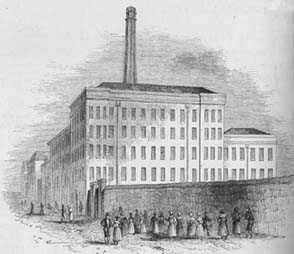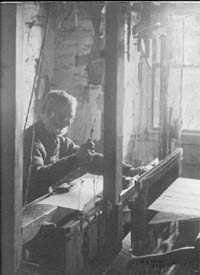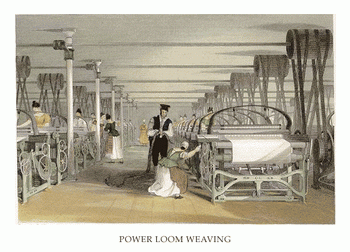The Linen Industry in the Lurgan Area
By Kieran Clendinning




 For well over two and a half centuries Irish linen, especially that woven in Lurgan and its surrounding villages had a world wide reputation for excellence. The story of its growth, development and the techniques by which it was prepared and manufactured before it reached the whole-sale warehouses for distribution may help to explain how this material gained such a high reputation. For well over two and a half centuries Irish linen, especially that woven in Lurgan and its surrounding villages had a world wide reputation for excellence. The story of its growth, development and the techniques by which it was prepared and manufactured before it reached the whole-sale warehouses for distribution may help to explain how this material gained such a high reputation.
The modern history of linen thread in Ireland began with the migration of John Barbour from Paisley to County Down in 1794. It was not, however, until the middle of the second decade of the 19th century that a great transformation in flax spinning took place. Prior to that time linen yarn had been spun only by hand on the old-fashioned spinning wheel.
In the year 1828 Mulholland's cotton mill in Belfast was burned to the ground. The family at once decided to re-build, but this time not for cotton but as a flax spinning mill. This mill went into production in 1830 in Henry Street, Belfast. This building was later enlarged due to the expansion of the York Street Flax Spinning Company. About the same time the family of Murlan, of Castlewellan, also began spinning flax by steam driven machinery. Messrs Hind and others followed in Belfast and by 1850 there were in Ireland 325,000 spindles producing linen yarns.
About the same period as the Mulholland's were operating in Belfast, thread making began to develop in the Banbridge area. The first spinning mill was built on the River Bann at Hazelbank, about 1834, by Samuel Law. Four years later Hugh Dunbar, from Huntly near Banbridge and William Stewart of Edenderry formed a partnership to build a spinning mill at Gilford.
In 1850 Ireland had 325,000 spindles, England had 365,000 and Scotland 303,000 (ie there was roughly the same number in each country). Over the next fifty years, however, the number of flax spinning spindles in England decreased to near vanishing point with less than 50,000 spindles. Even Marshall's, the leading firm, found it necessary to wind up their business, close their famous mill in Leeds, and transfer the business to America. By the end of the century Scotland had also suffered a major reduction, the number of spindles being 160, 000.
While these two countries had lost production, Ireland's share had increased and by 1875 there were 906,000 spindles working, this number having reached 935,411 by the turn of the century.
One of the reasons for this great displacement in favour of Ireland was the fact that linen was the staple industry here, whereas England and Scotland had other textile industries which allowed a higher profit and the payment of wages on a higher scale.
 Towards the end of the last century an average sized flax spinning mill contained about 22,000 spindles, and gave employment to about 750 persons. According to 19th century figures it cost about £4 to £6 a spindle to erect. This meant that the average cost of building a factory at this time was in advance of £120,000. Towards the end of the last century an average sized flax spinning mill contained about 22,000 spindles, and gave employment to about 750 persons. According to 19th century figures it cost about £4 to £6 a spindle to erect. This meant that the average cost of building a factory at this time was in advance of £120,000.
The work force employed in the mill was in the proportion of two or three females to one male. Children of both sexes at the age of 12 were also employed as learners. These were called "half-timers". They worked and went to school on alternative days and could not be employed unless they went to school.
Towards the end of the 19th century about £200 was spent in turning £100 of flax into the white goods ready for market, the finished product being worth about £300. The flax spinning business underwent many fluctuations of fortune in the last century. Sometimes it was profitable but frequently quite the contrary. During the American Civil War, the shortage in the supply of cotton turned so many to the use of linen that the price became enhanced and profits rose during the years 1863 - 68. During that time of prosperity a great increase in the number of spindles took place but, of course, when cotton supplies resumed their normal proportion the demand for linen goods diminished and for the next 30 years there were about seven lean years to one fat one. No fewer than 36 spinning mills were brought to insolvency or serious financial difficulty. Eighteen of them ceased to exist and while the others continued under new owners.
Power Looms
Power loom weaving was introduced to Lurgan as early as 1855 by James Malcolm with the building of a plant in Factory Lane. The commotion the building of this factory created among the hand-loom weavers was so great that they collected in a body and marched through the town demanding that it be shut down. Despite their clamour and protests the introduction of the power-loom had the blessing of the principal people of the town. Nothing, however, could halt progress and by 1866 the enterprising James Malcolm was making alterations and extensions to the factory to increase the number of power-looms for weaving cambric and cambric handkerchiefs.
About that time a power loom factory for the weaving of light and narrow linens, cost about £40 per loom while the weaving of wide damask or sheeting cost between £100 and £200. Wages were paid by piece work and the same scale applied to men and women. The light end of the work was done by the women and the heavy end by men. Work that fell between the two descriptions was carried out by either sex. Tenters and other skilled men were paid much higher rates. The number employed in and about a factory was somewhere about as many as the looms it contained.
 During the hand-loom period, different classes of linen goods had each its own locality of manufacture. The Huguenots are credited with the introduction of fine linen into Ireland especially in the Lisburn and Waringstown areas. Louis Crommelin, born in 1652, at Amandcourt in Picardy was engaged in the linen trade there but was forced, as a result of the revocation of the Edict of Nantes, to leave the country. He was about to settle in Holland, when, on the invitation of King William III, he and his son came to Ireland. In 1699 he was appointed Overseer of the Royal Linen Manufacture in Ireland. Crommelin died at Lisburn on 14th July 1727 aged 75 years, and he is buried with other Huguenots in the eastern corner of the churchyard of Lisburn Cathedral. During the hand-loom period, different classes of linen goods had each its own locality of manufacture. The Huguenots are credited with the introduction of fine linen into Ireland especially in the Lisburn and Waringstown areas. Louis Crommelin, born in 1652, at Amandcourt in Picardy was engaged in the linen trade there but was forced, as a result of the revocation of the Edict of Nantes, to leave the country. He was about to settle in Holland, when, on the invitation of King William III, he and his son came to Ireland. In 1699 he was appointed Overseer of the Royal Linen Manufacture in Ireland. Crommelin died at Lisburn on 14th July 1727 aged 75 years, and he is buried with other Huguenots in the eastern corner of the churchyard of Lisburn Cathedral.
William Waring
The settlement of a group of Huguenots in and around Waringstown perfected the manufacture of fine cambrics and lawns and bordered linen and cambric handkerchiefs. The word cambric comes from Cambrai, diaper is cloth d'Ypres and the word lawn is probably from the town of Laon.
Hand loom weavers in the Lurgan area brought their webs into Lurgan market to be sold. This market was founded by William Brownlow in accordance with a patent granted by William III. Linen merchants stood in the open street and made purchases, paying for and receiving the goods afterwards in the Black Bull Inn. At the beginning of the 19th century a Linen Hall was built in the Mall, Church Place by subscription. It was thronged every Friday by hand-loom weavers who placed their webs on specially built tables provided for the purpose. In 1825 the weekly sales averaged from £2,500 to £3,000. By degrees this manner of doing business was superseded by a middle-man or so called manufacturer, who bought yarn in large lots from the spinner, prepared the warps, and gave them out to the weaver. One of these manufacturers might succeed in having hundreds of weavers working for him. The accumulated webs of cloth were then brought to the Brown Linen market in Belfast.
One such manufacturer was James Brown who laid the foundation of his business at Lurgan in 1795. This business was to increase and multiply in the 19th century, trading under the name of John S Brown & Sons. It had at one time no less than 1,500 hand-loom weavers in Armagh, Down, Antrim and Tyrone. The Brown enterprise specialised in the weaving of monograms, crests, coats of arms and flags on linen. They supplied linen to the Queen and all the members of the Royal Family as well as steamship companies, railways, yacht clubs and hotels.
 The introduction of the power loom, however, sounded the death knell for this industry, and by the beginning of the present century hand-loom weaving was on the decline. In 1893 the estimated wages paid to hand-loom weavers were s6me-thing in the region of £220,000. By 1910, however, the amount paid was only £55,000. The introduction of the power loom, however, sounded the death knell for this industry, and by the beginning of the present century hand-loom weaving was on the decline. In 1893 the estimated wages paid to hand-loom weavers were s6me-thing in the region of £220,000. By 1910, however, the amount paid was only £55,000.
Parliament, in passing the Hand-Loom Weavers Protection Act in 1910, made an effort to revive the hand weaving of damask, cambric and diapers. By this time, however, the majority of hand-loom weavers were old men and the introduction of the old age pension meant that many who were still able to weave abandoned their looms on getting the pension.
Bleaching
When the woven material left the loom it was known as 'brown linen'' and it had to be bleached to make it white. The principal bleach greens in 17th century Lurgan were sited along the outflow from the lake to Lough Neagh in the town-lands of Dougher, Drumnakelly and Kinnego. Later as the industry increased this trade moved to sites and purpose built bleach houses along the River Lagan at Milltown and Donacloney and along the River Bann from Banbridge to Gilford.
The bleaching process could only be carried out in the long days between March and October, and it was produced by primitive methods such as boiling the linen in lye made from burnt seaweed and then spreading it on a grass field exposed to the effects of the sun, air, rain and artificial watering. After six months or so of this treatment the linen was steeped in buttermilk, washed in pure water and finished up.
As time progressed, however, so did the bleaching techniques improve and for many years towards the end of the last century the linen was bleached by the following method:
140 webs of yard wide brown linen, each one marked on the end with a red identification thread, were stitched together end to end for upwards of 10,000 yards.
 This was called a "pot". It was first passed through a solution of lime into boiling pots and then boiled for eight to ten hours. It was then drawn through a tank of water, after which the webs were unsewn and each one bundled separately. This was called a "pot". It was first passed through a solution of lime into boiling pots and then boiled for eight to ten hours. It was then drawn through a tank of water, after which the webs were unsewn and each one bundled separately.
The webs were then put through a wash mill with pure water for an hour, then steeped in a "sour" of dilute hydrochloric acid, to convert the residue of the lime into a soluble salt.
It was washed for a second time in the mills, boiled in soda lye which combining with the waxes and fats in the fibre, made them into soap and hence removable. The webs were washed again for the third time and afterwards put on the grass for some days, boiled again in lye, washed, put on the grass, rubbed in soap and water, boiled in lye, washed, put on the grass, and so on.
As soon as the material was considered to be sufficiently boiled the whitening process was begun by the use of bleaching powder or "dip" in which the cloth was left over-night. It was washed again, treated with a weak sulphuric acid, boiled again with soda lye, such processes being repeated until it was found to be of the proper whiteness. After this treatment the webs were once again stitched together and the process of finishing began.
The cloth was then breadthed by being passed through a water mangle between rollers which left just enough moisture for taking starch. It was then put into a tank filled with a mixture of starch and blue, after which it was passed over heated rollers to dry it.
The webs were once more unsewn and placed on beatling beams and beatled until they had thirty to sixty hours beatling.
They were then aired to the full width and calendered. This completed the work of the bleacher, the whole occupying eight to twelve weeks. The preparation of linen goods for the market was a somewhat elaborate process. When the webs were received from the bleaching works they were carefully examined and any defective portions laid aside.
They were then lapped or folded, and ornamented to suit the taste of each market. The goods were then bought by a merchant shipper who sold them to wholesale houses either at home or abroad to be placed on sale in the shops.
Our thanks to Kieran Clendinning for this article.


| 
